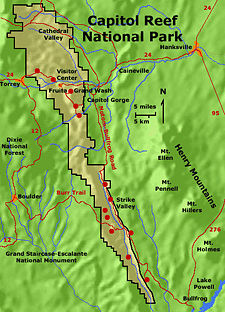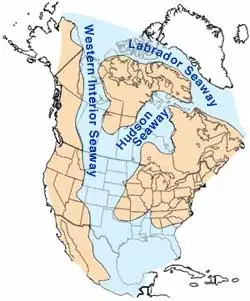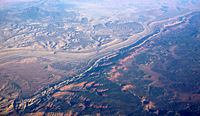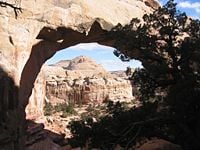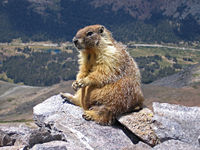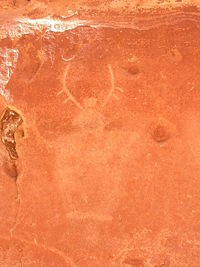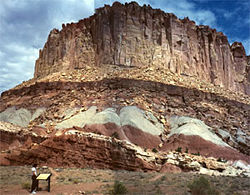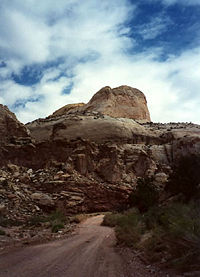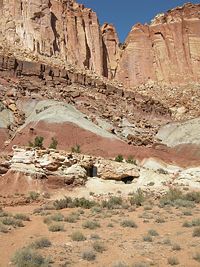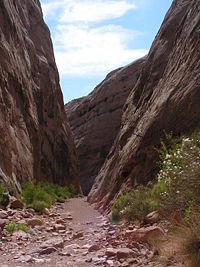Capitol Reef National Park
| Capitol Reef National Park | |
|---|---|
| IUCN Category II (National Park) | |
| | |
| Location: | Wayne, Garfield, Sevier, and Emery counties, Utah, U.S. |
| Nearest city: | Torrey |
| Area: | 241,904.26 acres (241,233.87 federal) 978.95 km² |
| Established: | December 18, 1971 |
| Visitation: | 511,511 (in 2006) |
| Governing body: | National Park Service |
Capitol Reef National Park is a United States National Park located in south-central Utah. Established as a national monument in 1937, it was designated a national park in 1971. Grand Staircase-Escalante National Monument and Glen Canyon National Recreation Area are adjacent to it on the southwest and south, respectively. The 378 mi² (979 km²) park was named Capitol Reef for a line of white domes and cliffs of Navajo Sandstone, each reminiscent of the U.S. Capitol building, that run from the Fremont River to Pleasant Creek on the Waterpocket Fold. Its rock towers and pinnacles resemble coral reefs. The park is 100-miles (160 km) long but fairly narrow.
The park, which lies along the northwestern edge of the Colorado Plateau, protects colorful canyons, ridges, buttes, and monoliths. About 75 miles (120 km) of the long up-thrust called the Waterpocket Fold, extending like a rugged spine from Thousand Lake Mountain southward to Lake Powell, is preserved within the park boundary. The Fremont River and its tributaries, Sulphur and Pleasant creeks, cross the formations through deep canyons that rise to more than 1,000 feet (300 meters). Pre-Columbian petroglyphs, created by people who lived in the area from about 700 to about 1300 C.E. line some of the smooth cliff walls of the park.
A landscape of fascinating scenery, it is breathtaking in its beauty—a grand display of three-dimensional artistry in rock, formed by years of natural erosion—the forces of water, wind, rock, and time.
Geography
Capitol Reef National Park encompasses the Waterpocket Fold, a wrinkle in the earth's crust that is 65 million years old. In this fold, newer and older layers of earth folded over each other in an S-shape. This wrinkle, probably caused by the same colliding continental plates that created the Rocky Mountains, has weathered and eroded over millennia to expose layers of rock and fossils. The park is filled with brilliantly colored sandstone cliffs, gleaming white domes, and contrasting layers of stone and earth.
The area was named for a line of white domes and cliffs of Navajo Sandstone, each of which looks somewhat like the United States Capitol building (hence its name), that run from the Fremont River to Pleasant Creek on the Waterpocket Fold.
The fold forms a north-to-south barrier that has barely been breached by roads. Early settlers referred to parallel, impassable ridges as "reefs," from which the park gets the second half of its name. The first paved road was constructed through the area in 1962. Today, State Route 24 cuts through the park traveling east and west between Canyonlands National Park and Bryce Canyon National Park, but few other paved roads invade the rugged landscape.
The park is filled with canyons, cliffs, towers, domes, and arches. The Fremont River has cut canyons through parts of the Waterpocket Fold, but most of the park is arid desert country. A scenic drive shows park visitors some of the highlights, but it runs only a few miles from the main highway. Hundreds of miles of trails and unpaved roads lead the more adventurous into the equally scenic backcountry.
Geology
The area that includes the park was once the edge of an ancient shallow sea that invaded the land in the Permian, creating the Cutler Formation. Only the sandstone of the youngest member of the Cutler Formation, the White Rim, is exposed in the park. The deepening sea left Carbonate deposits, forming the limestone of the Kaibab Limestone, the same formation that rims the Grand Canyon to the southwest.
During the Triassic, streams deposited reddish-brown silt, which later became the siltstone of the Moenkopi Formation. Uplift and erosion followed. Conglomerate, itself followed by logs, sand, mud, and wind-transported volcanic ash, then formed the uranium-containing Chinle Formation.
The members of the Glen Canyon Group were all laid down in the middle to late Triassic during a time of increasing aridity. They include:
- Wingate Sandstone: Sand dunes on the shore of an ancient sea.
- Kayenta Formation: Thin-bedded layers of sand deposited by slow-moving streams in channels and across low plains.
- Navajo Sandstone: Huge fossilized sand dunes from a massive Sahara-like desert.
The San Rafael Group consists of four Triassic-era formations, from oldest to youngest:
- Carmel Formation: Gypsum, sand, and limey silt laid down in what may have been a graben that was periodically flooded by sea water.
- Entrada Sandstone: Sandstone from barrier islands/sand bars in a near-shore environment.
- Curtis Formation: Made from conglomerate, sandstone, and shale.
- Summerville Formation: Reddish-brown mud and white sand deposited in tidal flats.
Streams once again laid down mud and sand in their channels, on lakebeds, and in swampy plains, creating the Morrison Formation. Early in the Cretaceous, similar nonmarine sediments were laid down and became the Dakota Sandstone. Eventually, the Cretaceous Seaway covered the Dakota, depositing the Mancos Shale.
Only small remnants of the Mesaverde Group are found, capping a few mesas in the park's eastern section.
Near the end of the Cretaceous period, a mountain-building event called the Laramide orogeny started to compact and uplift the region, forming the Rocky Mountains and creating monoclines such as the Waterpocket Fold in the park. Ten to fifteen million years ago, the entire region was uplifted much further by the creation of the Colorado Plateaus. Remarkably, this uplift was very even. Igneous activity in the form of volcanism and dike and sill intrusion also occurred during this time.
The drainage system in the area was rearranged and steepened, causing streams to downcut faster and sometimes change course. Wetter times during the ice ages of the Pleistocene increased the rate of erosion.
Biology
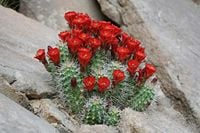
Much of Capitol Reef National Park has sparse desert-like vegetation. Piñon pines and junipers line the cliffs and slopes. Streams supports such plant life as cottonwoods, willows, and a profusion of other vegetation. Approximately 900 species of plants live within park boundaries. Capitol Reef has the highest concentrations of threatened or endangered plants of Utah's national parks.[1]
Fruit trees in the park include cherry, plum, apricot, pear and apple. Fremont cottonwood, exotic tamarisk, single leaf ash and numerous other trees are also found. Flowers near the Fremont River include such species as the legumes (vetches, locos, and blue lupine), and penstemons (firecracker, low and Palmer) which are common to most western areas. Desert wildflowers bloom in the more arid regions of the park, including many species of cacti. Prickly pear cactus, sego lily, and the Fremont barberry are found in the desert areas.
The large variety of birds in the park include many species of warblers, northern oriole, black headed and evening grosbeaks, catbirds and the yellow-breasted chat. Also seen are the mocking bird, sage thrasher, white throated swift, many species of swallows and the Golden Eagle. Mountain and western bluebirds migrate through the area on their way to nesting sites in the higher country to the west of the park.
Reptiles include many kids of lizards, the most common being the long western whiptail, the eastern fence lizard and the side blotched lizards. Gopher snakes and racers hunt mice and rodents, while water snakes are common along the river. Poisonous snakes include the prairie rattlesnake and the small midget rattlesnake.
Small mammals include marmots, rock squirrels, black tailed jackrabbits, and chipmunks. Beavers are found along the Fremont River. Larger mammals include the bobcat, cougar, ring-tailed cat, coyote, and fox. Less common, though present, are bighorn sheep and mule deer.
History
Native Americans
Fremont culture Native Americans lived near the perennial Fremont River in the northern part of the Capitol Reef Waterpocket Fold around 1000 C.E. They irrigated crops of lentils, maize, and squash and stored their grain in stone granaries (in part made from the numerous black basalt boulders that litter the area). In the thirteenth century, all of the Native American cultures in this area underwent sudden change, possibly due to a extended drought. The Fremont settlements and fields were abandoned.
Several centuries after the disappearance of the Fremont, both Utes and Southern Paiute moved into the area. These Numic speaking people named the Fremont granaries moki huts and thought they were the homes of a race of tiny people or moki.
Settlement
In the 1870s, settlers moved into the high valleys to the west, eventually establishing the towns of Loa, Fremont, Lyman, Bicknell, and Torrey.
In 1872, Alan H. Thompson, a surveyor attached to United States Army Major John Wesely Powell's expedition, crossed the Waterpocket Fold while exploring the area. Geologist Clarence Dutton later spent several summers studying the area's geology. None of these expeditions explored the Waterpocket Fold to any great extent, however, due to its excessive ruggedness.
Mormons settled the Fremont River valley in the 1880s and established the towns of Junction (later Fruita), Caineville and Aldridge. Fruita prospered due to annual fruit sales. Faced with frequent flooding of the Fremont River the other settlements did not survive. In addition to farming, lime was extracted from local limestone and uranium was extracted early in the twentieth century. In 1904, the first claim to a uranium mine in the area was staked. The resulting Olyer Mine in Grand Wash produced uranium ore.
By 1920, Fruita was steady though not necessarily prosperous. No more than ten families at one time were sustained by the fertile flood plain of the Fremont River and the land changed ownership over the years. The area remained isolated. The community was later abandoned and later still some buildings were restored by the National Park Service. Kilns once used to produce lime can still be seen in Sulphur Creek and near the campgrounds on Scenic Drive.
Early protection efforts
Local businessman Ephraim Portman Pectol, sensitive to the natural beauty of the area, organized a "Boosters Club" in 1921, in an effort to promote the area. His brother-in-law, Joseph S. Hickman, joined in Pectol's efforts. In 1924, organized the Wayne County-wide Wayne Wonderland Club. That same year, Hickman was elected to the Utah State Legislature.
Pectol was elected to the presidency of the Associated Civics Club of Southern Utah, successor to the Wayne Wonderland Club. Photographer J.E. Broaddus was enlisted to travel and lecture on "Wayne Wonderland." Pectol was elected to the legislature in 1933 and almost immediately contacted President Franklin D. Roosevelt petitioning for the creation of "Wayne Wonderland National Monument" out of the federal lands comprising the bulk of the Capitol Reef area.
Following feasibility studies and boundary assessments, President Roosevelt signed a proclamation creating Capitol Reef National Monument on August 2, 1937, setting aside 37,711 acres (152 km²) of the Capitol Reef area.
However, the Great Depression years were lean for the National Park Service (NPS), the administering agency, and there were no funds available. It took a number of years for the first rangers to arrive. In the meantime, administration of the new monument was placed under the control of Zion National Park, 230 miles to the southwest. A stone ranger cabin and the Sulphur Creek bridge were built and some road work was performed by the Civilian Conservation Corps and the Works Progress Administration.
Administration of the monument
Historian and printer Charles Kelly came to know NPS officials at Zion well and volunteered to "watchdog" the park for the NPS. In 1943, he was officially appointed "custodian-without-pay." He was to work without pay as a volunteer until 1950, when the Park Service offered him a civil service appointment as the first superintendent.
During the 1950s, Kelly was deeply troubled by NPS management acceding to demands of the U.S. Atomic Energy Commission that Capitol Reef National Monument be opened to uranium prospecting. He felt that the decision had been a mistake and destructive of the long term national interest. As it turned out, there was not enough ore to justify mining in the monument.
It was not until 1958 that Kelly got additional permanent help in protecting the monument and enforcing regulations; Park Ranger Grant Clark transferred from Zion. The year Clark arrived, fifty-six thousand visitors came to the park and Charlie Kelly retired for the last time, full of years and experiences.
During the 1960s, National Park Service areas nationwide received new facilities to meet the growing public interest in national parks. At Capitol Reef, a 53-site campground at Fruita, staff rental housing, and a new visitor center were built, the latter opening in 1966. The all-weather State Route 24 was built in 1962 through the Fremont River canyon near Fruita, increasing visitation dramatically. In 1967, 146,598 persons visited the park, necessitating a larger staff.
Just prior to President Lyndon B. Johnson leaving office in 1968, he set aside an enormous area of public lands. In Presidential Proclamation 3888, an additional 215,056 acres (870 km²) were placed under NPS control.[2] By 1970, Capitol Reef National Monument had accumulated 254,251 acres (1,028 km²) and stretched southeast from Thousand Lake Mountain nearly to the Colorado River.
National park status
The vast enlargement of the monument and diversification of the scenic resources soon raised another issue: Whether Capitol Reef should be a national park, rather than a monument. Two bills were introduced into the United States Congress, one calling for a 180,000-acre (728 km²) national park and an adjunct 48,000-acre (194 km²) national recreation area where multiple use (including grazing) could continue indefinitely. The other provided for a 230,000-acre (930 km²) national park alone accompanied by a 25-year phase-out of grazing. Disagreements between the Senate and Congress led to the establishment of a Conference Committee who issued an agreeing report on November 30, 1971. The legislation—"An Act to Establish The Capitol Reef National Park in the State of Utah"—became Public Law 92-207 when it was signed by President Richard Nixon on December 18, 1971.
Notes
- ↑ John William Uhler, Capitol Reef National Park Information Page.
- ↑ National Park Service, Development and Administration. Retrieved December 10, 2008.
ReferencesISBN links support NWE through referral fees
- Harris, Ann G., Esther Tuttle, and Sherwood D. Tuttle. 1990. Geology of national parks. Dubuque, IA: Kendall/Hunt Pub. Co. ISBN 9780840346193.
- National Park Service. Capitol Reef Development and Administration. Retrieved December 10, 2008.
- National Park Service. Capitol Reef National Park. Retrieved December 10, 2008.
- Reader's Digest Association. 1993. National Parks. Explore America. Pleasantville, NY: Reader's Digest Association. ISBN 9780895774477.
- The National Parks: Index 2001–2003. Washington: U.S. Department of the Interior.
- United States. 2001. Capitol Reef National Park, Utah. Washington, D.C.: National Park Service.
| National parks of the United States | |
|---|---|
| Acadia • American Samoa • Arches • Badlands • Big Bend • Biscayne • Black Canyon of the Gunnison • Bryce Canyon • Canyonlands • Capitol Reef • Carlsbad Caverns • Channel Islands • Congaree • Crater Lake • Cuyahoga Valley • Death Valley • Denali • Dry Tortugas • Everglades • Gates of the Arctic • Glacier • Glacier Bay • Grand Canyon • Grand Teton • Great Basin • Great Sand Dunes • Great Smoky Mountains • Guadalupe Mountains • Haleakala • Hawaii Volcanoes • Hot Springs • Isle Royale • Joshua Tree • Katmai • Kenai Fjords • Kings Canyon • Kobuk Valley • Lake Clark • Lassen Volcanic • Mammoth Cave • Mesa Verde • Mount Rainier • North Cascades • Olympic • Petrified Forest • Redwood • Rocky Mountain • Saguaro • Sequoia • Shenandoah • Theodore Roosevelt • Virgin Islands • Voyageurs • Wind Cave • Wrangell-St. Elias • Yellowstone • Yosemite • Zion List by: date established, state |
Credits
New World Encyclopedia writers and editors rewrote and completed the Wikipedia article in accordance with New World Encyclopedia standards. This article abides by terms of the Creative Commons CC-by-sa 3.0 License (CC-by-sa), which may be used and disseminated with proper attribution. Credit is due under the terms of this license that can reference both the New World Encyclopedia contributors and the selfless volunteer contributors of the Wikimedia Foundation. To cite this article click here for a list of acceptable citing formats.The history of earlier contributions by wikipedians is accessible to researchers here:
The history of this article since it was imported to New World Encyclopedia:
Note: Some restrictions may apply to use of individual images which are separately licensed.

